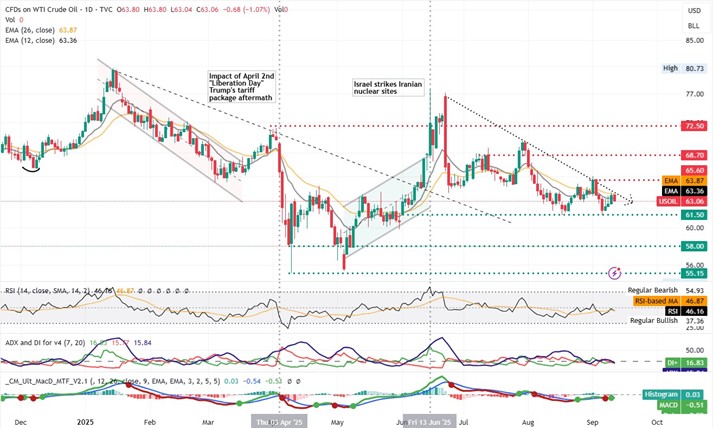- Crude futures remain supressed near the $63 per barrel area, as traders place more emphasis on long term oversupply projections and assign minimal concern on evolving geopolitical tensions and possible disruptions.
- Earlier this week, the Israeli military carried out strikes of Hamas leadership in Doha, Qatar, marking a further escalation of its ongoing campaign across the Middle East and energy traders are sitting at the edge of their seats, bracing for a similar reaction observed at the start of June, when Israel fired missiles towards Iran.
- Meanwhile, US President Donald Trump said on Sunday he was ready to move to the second phase of restrictions against Russia after its heaviest aerial strikes on Ukraine since the war began, fuelling worries about disruptions to global energy flows.
- Two days later, nineteen Russian drones entered Polish airspace after missing their targets in Ukraine and forced the mobilization of NATO warplanes to shoot them down. The Polish army denounced it as an “act of aggression” and Donald Tusk, the country’s prime minister, noted that it was the first time Russian drones had been shot down over NATO territory and demanded the supply of defence systems from allied nations.
- Post the incident, President Trump has urged the EU leadership to impose 100% tariffs on Chinese and Indian goods to pressure Russia to come back to the negotiations table and end the war in Ukraine.
- Weekly crude inventory data also reinforced the case of softness in demand, as stockpiles rose by 3.9 million barrels, recording an excess of 2 million barrels above market expectations which saw a modest draw of 1 million.
- Saudis, the head of the oil cartel, OPEC, are expected to boost oil exports as the nation’s domestic consumption demand targets have been met, fast tracking the return of priorly halted output.
- The organization will release its monthly report later on today and markets bracing for a confirmation that oil output will further rise in the months ahead.
- Finally, senior analysts from UBS assess the global oil demand hit its highest point in August, as the summer travelling season across Northern Europe has peaked and now a slowdown in Autumn is expected, as temperatures moderate.
Technical Analysis of Oil
WTI Chart – Crude stays stuck near the $63 per barrel area ahead of OPEC’s monthly report

- Resistance: 65.60 (R1), 68.70 (R2), 72.50 (R3)
- Support: 61.50 (S1), 58.00 (S2), 55.15 (S3)
The bears remained in control over the past week despite the flurry of geopolitical incidents and formed a base above the $61.50 (S1) area. At the same time however price action currently remains below the descending trendline incepted since the 23rd of June and hence we maintain our bearish outlook bias for the commodity, weighing at the same time the odds for a possible return of price action to the $65 per barrel area should catalysts gain potency.
Supporting our case is the RSI with a value of 46, showcasing modest bearish pressure and both MACD and signal line remaining below threshold. At the same time both -DI and +DI merging alongside a depressed ADX, signals neither the bulls nor the bears have enough strength and momentum dwindled.
Should the bears maintain control and extend their reign, we would reasonably expect to see a break below, $61.50 (S1) support level, and head south, towards the $58.00 (S2) support zone, and hit 3 and half month lows. Should on the other hand the bulls regain the initiative, we may see the commodity climbing above the $65.60 (R1) closest resistance level and after a successful break and head on to challenge the $68.50 (R2) area.
